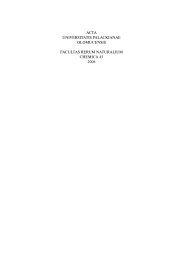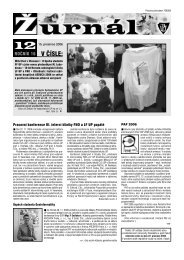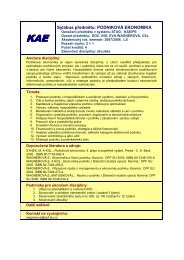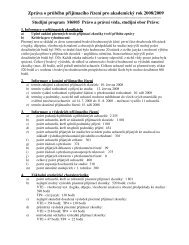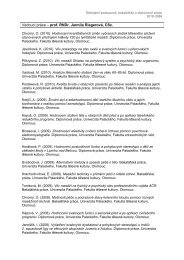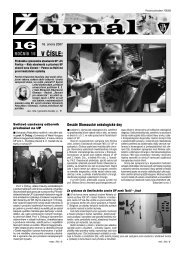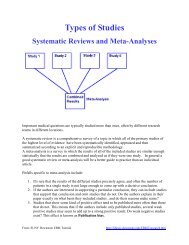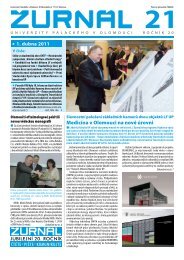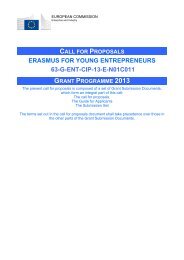ACTA UNIVERSITATIS PALACKIANAE OLOMUCENSIS GYMNICA ...
ACTA UNIVERSITATIS PALACKIANAE OLOMUCENSIS GYMNICA ...
ACTA UNIVERSITATIS PALACKIANAE OLOMUCENSIS GYMNICA ...
- No tags were found...
You also want an ePaper? Increase the reach of your titles
YUMPU automatically turns print PDFs into web optimized ePapers that Google loves.
72 Acta Univ. Palacki. Olomuc., Gymn. 2004, vol. 34, no. 2Programmed learning was especially accepted inrelation to more theoretical subjects, however, between1969 and 1970, the possibilities of using this methodin the process of physical education began to be studied.Motor tasks which are the object of learning arepresented by the use of a properly-prepared program(booklets and boards with relevant instructions). Theprogram for learning a new motor activity/function isa precisely-ordered linear sequence of methodical exercisesand activities leading via the shortest way towardsmastering new movement skills (Strzyżewski, 1986).The program is equipped with objects playing the roleof a regulator of movements produced by exercisingstudents and a measure of a well- or badly- done motortask. They allow students an individual assessment oftheir work directly after completion of an exercise andthe adequate management of further steps in the courseof learning.The most widespread form of programmed learningin physical education are programmed cards (Czabański,1991; Czabański & Guła-Kubiszewska, 1993; Wieczorek,1999). One should separate subsequent sensomotoric sequenceswithin the motor activity which is being taughtand then present them in a graphic form with verbalinstruction. Often, programmed teaching is employedin conjunction with other methods (e.g. in Germanyand Austria).The aim of the present work was to define motor effectsin the process of learning new motor activities withthe use of two different forms of programmed learningin conjunction with other methods:1. A linear program for learning “juggling with balls”connected with the analytic method (learning byparts) – a chart (large scale illustration) program(Wieczorek, 1999).2. A branched program for learning “the Tai-chi system”connected with a synthetic method (wholelearning/learning by wholes) – computer-aidedprogrammed learning (Guła-Kubiszewska, 2000).In the linear program, developed as large-scale illustrations(charts), students engage in self-regulatingactivities after each step and they receive feedback onthe level of execution of a given motor sequence withoutdelay. In the computer-aided program self-regulating activitiesare connected with regulation of the representationof a plan and program of a motor activity.The received feedback informs the learner about theprecision of representation of the course of movement,whereas a motor activity is performed as a whole. Theexecutive control allows further facilitation of motorrepresentation programming. In programmed learning,Internal Programming Strategy was employed in theform of a cognitive strategy as well as a metacognitiveone (Guła-Kubiszewska, 2002).The following research questions have been formulated:1. What level of motor effects has been reached by theuse of the classic programmed learning and computer-aidedteaching?2. Was the manner of performing executive control(whole or part) related to the effectiveness of motorlearning?MATERIAL AND METHODS OF RESEARCHResearch was carried out in the years 2000–2003among: the soldiers of Basic Military Service in Koszalin(60 people), female students of Higher VocationalSchool in Legnica as well as the employees of DPSDom Pomocy Społecznej [Social Assistance Home]in Legnickie Pole (30 people) as well as students ofthe first year of Wrocław University School of PhysicalEducation (group I – 46 people, group II – 47 people).The average age of both groups was 19–24 years.The method of research was the pedagogical experiment.The examined learners after having familiarizedthemselves with the aim of learning as well as havingperformed motivational activities encouraging learningtook up activities in compliance with the foundationsof the program. They took the decision concerning thecompletion of learning on their own.RESULTSIn the process of motor learning using the classicprogrammed learning, motor effects were measuredby the number of steps which the examined learnersmastered over the course of time. The other measure– called the Learning Speed Index (LSI) – was calculatedbased upon the rate of increase of skills in thesubsequent stages of learning (Wieczorek, 1998).This value is proportional to the area under thecurve of learning, where on the axis of ordinates thenext steps of learning have been marked and on theaxis of abscissae where the next stages of learning havebeen marked. This enables the division of the learningstudents into groups of slow, medium and fast rate resultincrease.Among the examined soldiers the highest percentagewas reached as regards step three (38.1%) and stepfour (31.2%). Of the examined soldiers, 29.7% werecompletely successful in learning, meaning that step sixwas achieved. Within the group of female students andemployees the scope of mastering the program is verysimilar. Most of the examined learners mastered themotor activity at the level of step four (43.3%) and stepthree (26.7%). Only 10% of the examined learners masteredthe motor task well, however the soldiers obtainedbetter effects of learning a motor activity (Fig. 1).



